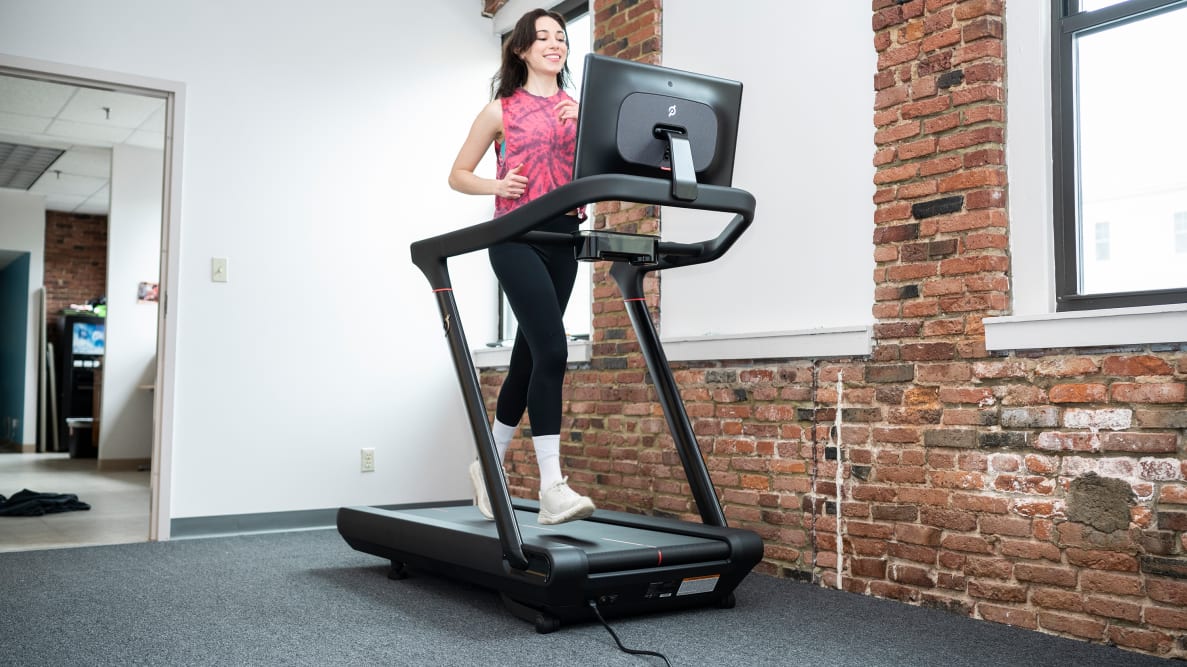Pros
-
Seamless integration with Peloton classes
-
Intuitive design
-
Looks great
Cons
-
Screen can wobble during high-intensity efforts
-
Instructors might call out unavailable features
What is the Peloton Tread?
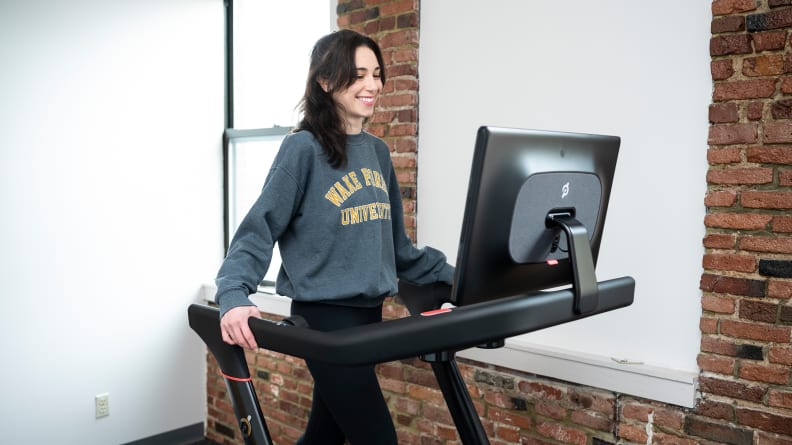
I loved my time with the Tread.
Peloton has sold a treadmill since 2018—a $4,295, spaceship-esque behemoth with a high-end, slatted 20-inch wide, 67-inch long running belt and a 32-inch touchscreen. Last summer, the company announced that this treadmill would be rebranded as the Tread+ and introduced a lower-cost option as the new Tread. To call the $2,495 Tread a “downgrade” is not quite accurate, as pretty much all things Peloton creates are inherently fancy (and have the price tags to match).
Instead, it’s more “pared-down” than scrimped, with a slightly smaller screen at 23.8 inches (still more generous than most other treadmills) and a standard continuous nylon, 20-inch wide, 59-inch long belt (shorter, but not any less wide, than the Tread+’s belt). The Tread is also missing one of the Tread+’s features, Free Mode, which allows you to disengage the motor and power the belt with your own feet by bracing your hands on the handlebars. This is a nice bonus for activating different muscles and varying the Tread+ workouts, but nothing most people expect from their treadmills. Both the Tread and the Tread+ have a max user weight of 300 pounds. The Tread’s max speed is 12.5 miles per hour (mph), or about a 4:48 minute-per-mile pace, and its max incline is 12.5%—the same as the Tread+'s max speed and a little less than its 15% max incline. Still, the Tread is our Upgrade Pick over our Best Overall NordicTrack 1750, as it has a bigger screen and better studio-style programming, offers a more elegant, user-friendly design, and costs about $600 more. The Tread was supposed to be released in late May 2021, but Peloton pushed the launch back after a number of confirmed injuries linked to the Tread+ and concerns about the stability of the Tread's touchscreen. Along with its new release date, the Tread has a new feature called Tread Lock, which requires users to enter a four-digit code before starting the machine, and claims its screen is more secure.
When you buy the Tread, you must include at least one month of the $39 monthly all-access Peloton membership, which provides access to the live and on-demand classes and the leaderboard, i.e., the list showing how you compare to others who've taken the class and your own past performance in similar classes. After that month, you can cancel the membership—but, in my opinion, that kind of defeats the purpose of having the Tread in the first place. If you don’t want to pay the whole cost of the machine up front, Peloton offers no-interest financing for $64 a month for 39 months, plus that $39 monthly membership fee. Delivery and assembly are included with purchase. Let’s get into it.
What we like about the Peloton Tread
It offers incredible studio-style classes
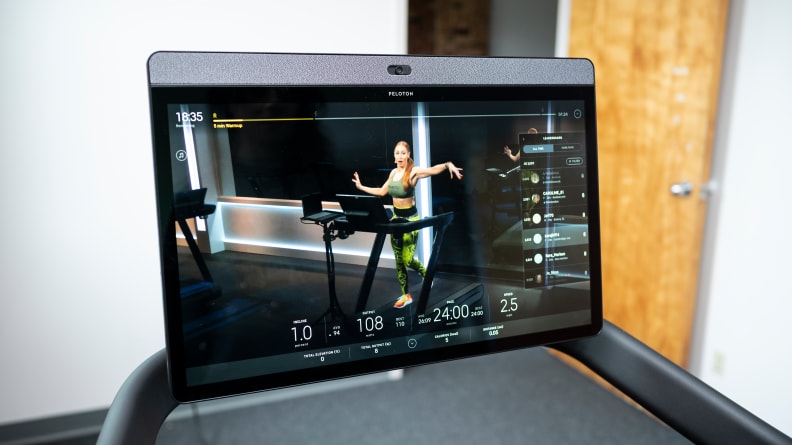
Peloton's instructors are fun and charismatic.
Most Peloton owners—whether they have the bike or a tread—would agree that the best part of having the equipment is its live and on-demand classes. With the Tread, you have four main options for workout sessions, all between 20 and 60 minutes long: walking classes (which range between easy strolls and power walks, usually supplemented by some incline); running classes (which may be centered around hills, endurance, and intervals, or more of a “fun run” with a certain musical theme); combined walking and running classes; and bootcamp classes (running intervals interspersed with off-Tread weight training, for which you may need additional equipment).
In addition to the extensive on-demand library, a handful of live classes are offered every day between the hours of about 7 a.m. and 7 p.m Eastern time. Additional off-Tread classes can be accessed via the Tread’s screen or a separate app-enabled device—these include HIIT, strength training, yoga, Pilates, barre, stretches, and outdoor running and walking classes. The workouts, led by Peloton’s charismatic instructors, are fun, well-produced, and feature great playlists that you may preview before starting the class to ensure the music is to your liking. I had a few favorite coaches by the end of my testing period, but every instructor is engaging and every class I took made me want to keep using the Tread.
The speed and incline controls are incredibly intuitive
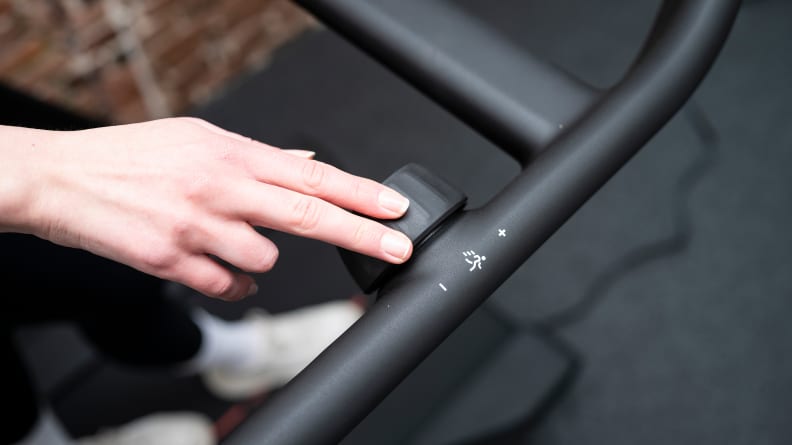
You adjust the Tread's speed and incline with knobs instead of tactile buttons.
The Tread is well designed and doesn’t have many buttons, like the up/down ones you’ll see for adjusting the speed and incline on other treadmills. Instead, the speed and incline are controlled by knobs on the right and left handrail, which you adjust with a twist or even just a flick of your palm. I loved using these knobs, as I found them much easier than fumbling to hit buttons or tap screens. And because you’re watching the instructors on the screen adjust their Treads in the same way, it feels intuitive.
You may also customize three shortcuts each for your own favorite speed and incline settings on the touchscreen. I thought the shortcut buttons were a little small and tough to hit accurately, especially when I was finishing up a sprint interval—in those cases, I would have appreciated a solid, tactile button—but the knobs make it so quick and easy to change the settings that I didn’t find myself relying on the shortcuts too much.
The metrics display is detailed and customizable
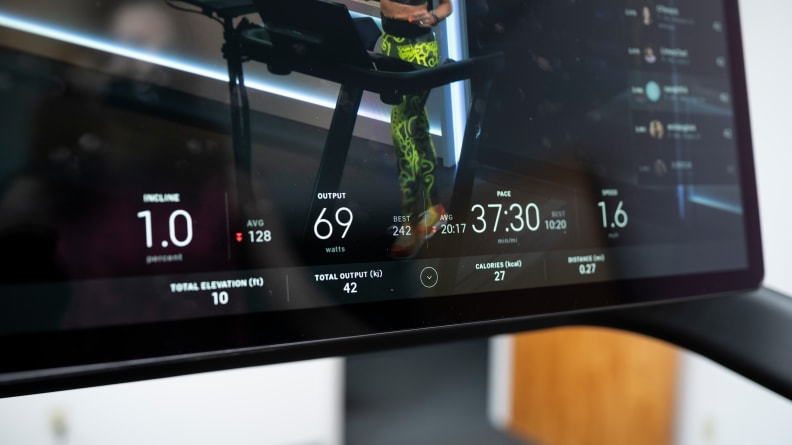
The Tread screen shows all the information you might want to see.
The Tread’s screen is big—it’s 13 inches larger than the screen on our Best Overall treadmill, the NordicTrack Commercial 1750. Even so, when you start a class, the screen looks a little busy. But that’s just because it contains all the information you might want during your class: pace, average speed, mileage, elevation gain, time remaining in the class, calories burned, and the song that’s currently playing. There’s also the leaderboard, which, in addition to tracking your performance, allows you to send virtual “high fives” to fellow Peloton runners.
However, if you’re overwhelmed with data, you can hide any or all of it as you see fit. You can send away everything all at once with a double tap on the screen, so the only thing you’re looking at throughout the class is the instructor, or you may swipe away each section individually. For example, seeing a countdown for the time remaining in the class often depresses me rather than motivates me unless I’m at least halfway through, so I preferred hiding the timer until I thought I was at a point where I could handle the numbers ticking down. I also enjoy seeing the leaderboard but sometimes found that I hyperfocused on it to the point where it distracted me from the class. I liked having the ability to get rid of it whenever I got fixated on leaving “PeloFan123” in my dust.
You can create a fuller workout by queuing classes
When I tried the Tread, I also got a chance to try one of its newer features, “Stacked Classes” (available on all Peloton equipment and the app). This feature allows you to queue up to 10 classes in a row—say, a 30-minute run followed by a 10-minute strength class followed by a 10-minute ab workout followed by a five-minute cooldown stretch (you know, if you’re feeling motivated). When you’re done with one class, a prompt for the next one immediately pops up, so all you have to do is press play. It’s a small but nice touch that makes a full-body workout much easier by planning it out in advance, especially if you want to do some strength training after a run but don’t feel like sifting through all the available options in your post-cardio haze.
What we don’t like about the Peloton Tread
The screen bounces during sprints
Because the Peloton Tread is specifically designed for taking Peloton classes, it has some annoying features that most other treadmills don’t have, and is missing some features that other, cheaper treadmills do have. One noticeable one: Because its screen is so large and extends above the console, I noticed that it tended to wobble some during high-intensity sprints—not so much that the instructor ever looked blurry, but enough that it sometimes made it tough to use the touchscreen while I was running.
The Tread is large and doesn’t fold up
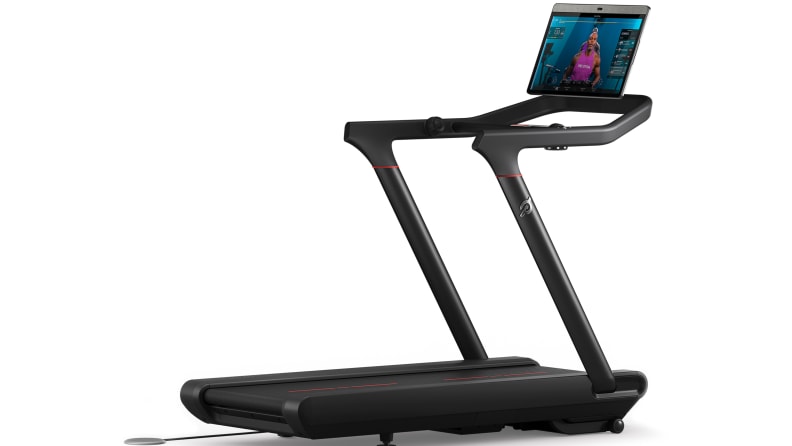
The Tread takes up a lot of space—and doesn't fold up.
The Tread's deck doesn’t fold up into the console, a feature you'll find in other home-use treadmills including the NordicTrack. The Tread looks really cool and is almost a statement piece, so it’s not the worst thing to have out all the time if you don’t have a designated space for a home gym—and you don’t mind fielding “Hey, is that a Peloton?” questions every time someone walks into your living room. And though it can be tilted and pushed on its small front wheels, at 68 inches long, 33 inches wide, and 62 inches tall and weighing 290 pounds, it's not something you can plan on shoving somewhere to stow away when it isn’t in use.
It has so many features, but no fan
Almost every other treadmill I tried had a built-in fan, but the Peloton Tread does not. If you want a breeze, you could clip a miniature fan to the water bottle holder, roll a larger fan in front of it (which is what I did), or position the Tread in front of a window you can open—but you won’t get any breezy relief from the machine itself.
You’ll notice that Free Mode is missing
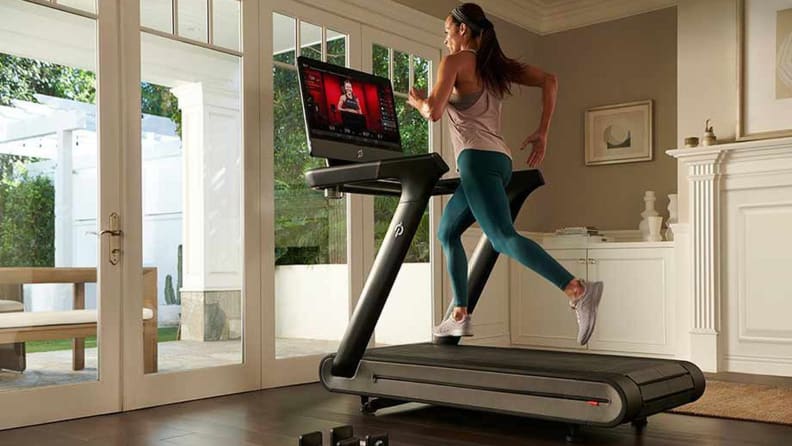
The most of the Peloton instructors use the Tread+, so you may find yourself missing it.
When I tested the Tread, I took a few classes that gave me Tread+ envy. This is because the instructors called for using the Free Mode feature that, again, the Tread does not have. Before I started a class with a Free Mode segment, I got a notification telling me to just run at a high speed when the instructor called for it, but I still felt unmoored (and jealous while watching the instructor on the screen) during those bouts.
Because I tried the Tread before it officially hit the market, I’m hopeful that future classes will include relevant instruction for Tread and Tread+. Either way, Free Mode usually isn’t used for very long, so it didn’t detract from my overall workout experience too much.
What is Peloton’s trial, warranty, and return period like?
Like all Peloton products, you can return the Tread within 30 days (for a refund minus an additional fee for shipping and handling) if it isn’t to your liking. You may also be charged extra if the Tread is damaged.
Its warranty is also fairly disappointing given the Tread's cost: You get three years on the frame, motor, and belt, and one year on the components, screen, and labor. You can also add an additional service plan within your first year of purchase for $270 or $325 that adds on an additional 12 or 27 months of parts and labor coverage. If you opt for financing, this is probably a good call, so you’re covered at least until you’re done paying it off.
How does the Peloton Tread compare to the NordicTrack Commercial 1750?
If you're thinking of getting a new treadmill, you may be torn between the $2,495 Peloton Tread and the $1,799 NordicTrack Commercial 1750, our best overall treadmill pick. Their basic specs are pretty similar: The Peloton Tread's speed ranges from 0.5 mph to 12.5 mph and NordicTrack's tops out a little lower at 12 mph (still, a 5-minute-mile pace). There's more of a disparity in the incline—0.5% to 12.5% with the Tread and -3% to 15% with the NordicTrack (yes, it goes downhill, which can be useful for training for hikes or just adding more variety to runs).
Aesthetically, there's no competition—the Tread's 68-inch long, 33-inches wide, and 62 inch-tall frame looks much better than NordicTrack's chunky 81.25 inches long, 39.25 inches wide, and 62.75-inch tall build. However, the NordicTrack's deck folds up, which means it doesn't always take up its max footprint.
But the biggest difference for most people will be the streaming workout classes. NordicTrack's 10-inch screen plays classes from its workout platform iFit, which features trainers leading outdoor runs all over the world and a nifty feature that allows the treadmill platform to adjust automatically to match the speed and incline requests of the trainer. The Tread's screen is significantly larger (13 inches) and plays studio-style classes to which the machine does not auto-adjust. In my experience, I found Peloton's user interface much easier to use and understand—it has better organization and overall flow—but it's not too hard to get the hang of iFit. That said, iFit is also included for free with your first year with the NordicTrack, and you have to start shelling out right away for Peloton's programming.
NordicTrack’s warranty is also a lot better, providing 10 years on the frame (to Peloton's three), two years on parts, and one year for labor plus you can opt for service plans (for an additional cost) for regular tune-ups, which Peloton does not offer.
All in all, both are great treadmills. Your decision will ultimately come down to the streaming platform and class style you prefer—and the price you're willing to pay for it.
Is the Peloton Tread worth it?
At $2,495 (plus the monthly app fee), the Peloton Tread is unlikely to be a casual purchase for most people—even with no-interest financing, and even considering its diminished cost compared to the Tread+. Here’s where I come down on it: All in all, you don’t need the Tread if you just want a great quality treadmill (though you’ll get that), but as a platform for Peloton’s excellent programming, it excels.
If you’ve never taken a Peloton class, I’d recommend checking out the app before you commit to the machinery—it offers a free 30-day trial, so you have plenty of time to do this without paying a cent. This will give you a chance to familiarize yourself with the class style and instructors, and you can also preview the treadmill classes on any treadmill—and even get a longer-term hacked Peloton experience for a lot less money. At $12.99 a month for the standalone app versus $39.99 a month for the all-access app needed for the Tread, I wouldn’t blame anyone for doing this, though you miss out on the leaderboard, the possible shoutouts from the instructors, and (of course) the sleek Peloton equipment this way.
That said, if you find that you (like me) love the classes and instructors and (unlike me) have some space and cash to spare for investing in the equipment, I’m confident you’ll love the Peloton Tread.
Get the Peloton Tread at onepeloton.com
Meet the tester
Sara Hendricks is a former Health and Fitness editor for Reviewed. She has several years of experience reading and writing about lifestyle and wellness topics, with her previous work appearing in Refinery 29, Insider, and The Daily Beast.
Checking our work.
Our team is here to help you buy the best stuff and love what you own. Our writers, editors, and experts obsess over the products we cover to make sure you're confident and satisfied. Have a different opinion about something we recommend? Email us and we'll compare notes.
Shoot us an email